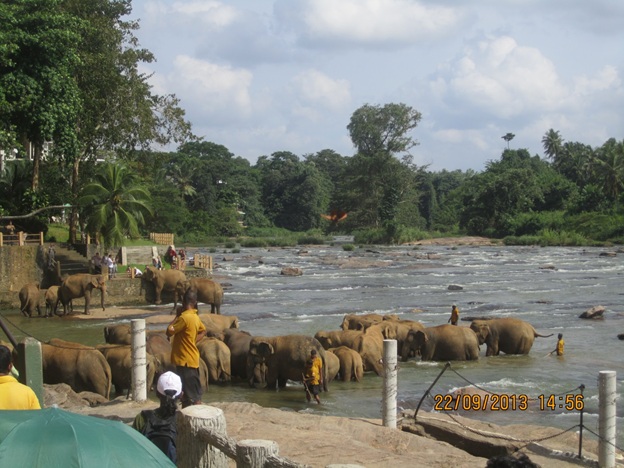Last week the first year zoology students were taken to the Elephant Orphanage in Pinnawala on a field visit, to carry out sampling. This was part of the ZL 1010 – Animal Behaviour course unit.
We have been taught 3 main methods of sampling in class and the learning outcome of this visit was to become familiar with these methods.
- Ad Libitum (‘at liberty) Sampling is where you casually observe the animals and become familiar with the animals’ behavior.
- Scan Sampling is where you scan the entire group of animals over a defined period of time and note down the different types of behavior shown by the animals.
- Focal Animal Sampling is where you focus on a single animal and record its behavior. Since this had to be carried out both on land and in water (when they’re taken for their bath in Maha Oya) we had to pick an elephant that could be easily identified. The mahouts were very helpful in giving us information about the elephants. For instance, my focal animal was an 18 year old female called Sapumali who had been rescued from Uda Walawe.
Till about 10.00am the weather was quite pleasant; sunny but plenty of breeze. However as the hours passed on it got hotter and the air became more and more still and it reached a point where we could no longer concentrate on the animals as the heat was too much to bear!
After lunch we went to Maha Oya for a second round of sampling and then it was time to head back to Colombo. All in all it was a very interesting field visit. It was not my first time to Pinnawala, but it was definitely the first time that I paid so much attention to a single animal. And having watched them so closely, it got me thinking about animal conservation and its importance.
The Pinnawala Elephant Orphanage is an example of a type of Ex-situ conservation. That is, the animals are conserved in an enclosure outside their natural habitat.
Founded in 1975, the orphanage was set up off Rambukkana Road in Kegalle, by the Department of Wildlife Conservation, utilizing 25 acres of land. Their main aim was to take care of the baby elephants that had lost their mothers. In 1978 the Elephant Orphanage was taken over by the National Zoological Gardens and a captive breeding program was introduced 4 years after.
The elephants at Pinnawala are controlled and later trained as work animals by their ‘mahouts’ (keepers) with whom they usually have a strong bond. One word by the mahout can control an entire herd of elephants. It goes to show the ‘power’ of the ‘ankus’ or the traditional elephant training tool. This long stick has a sharp metal point at one end which is used to control the elephants. It is indeed the threat of the pain that helps discipline these animals. Yet the use of it cannot always be justified.
The elephants are taken to bathe in the nearby river for 2 hours twice a day and most of them are free to roam the grounds of the sanctuary unless they show signs of aggression or in the case of males, signs of musth.
What started with 5 elephants is home to about 75 elephants today. It’s a major tourist attraction, both locally and internationally. As a result, there is a lot of money coming in. This is good because this money can be used to ensure that the elephants are well fed and well looked after.
However, the only way to ensure the long-term survival of any species is to preserve its natural habitat and enforce conservation management that includes the education of the public about the value of elephants.

